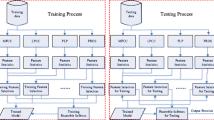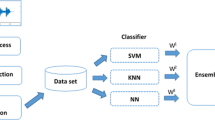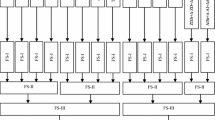Abstract
In the recent past, handling the curse of dimensionality observed in acoustic features of the speech signal in machine learning-based emotion detection has been considered a crucial objective. The contemporary emotion prediction methods are experiencing false alarming due to the high dimensionality of the features used in training phase of the machine learning models. The majority of the contemporary models have endeavored to handle the curse of high dimensionality of the training corpus. However, the contemporary models are focusing more on using fusion of multiple classifiers, which is barely improvising the decision accuracy, if the volume of the training corpus is high. The contribution of this manuscript endeavored to portray a novel ensemble model that using fusion of diversity measures to suggest the optimal features. Moreover, the proposed method attempts to reduce the impact of the high dimensionality in feature values by using a novel clustering process. The experimental study signifies the proposed method performance in term of emotion prediction from speech signals and compared to contemporary models of emotion detection using machine learning. The fourfold cross-validation of standard data corpus has used in performance analysis.




Similar content being viewed by others
Abbreviations
- SER:
-
Speech emotion recognition
- ML:
-
Machine learning
- MFC:
-
Mel-frequency cepstral coefficient
- LPCC:
-
Linear predictive cepstral coefficient
- PLP:
-
Perceptual linear prediction
- ZCR:
-
Zero-crossing rate
- DNN:
-
Deep neural network
- CWT:
-
Continuous wavelet transforms
- EMD:
-
Empirical mode decomposition
- MS:
-
Modulation spectral
- HAF:
-
Hybrid acoustic features
- DFODM:
-
Digital feature optimization using fusion of diversity measures
- WSR:
-
Wilcoxon signed-rank
References
Alonso, J. B. (2015). New approach in quantification of emotional intensity from the speech signal: Emotional temperature. Expert Systems with Applications, 42(24), 9554–9564.
Basu, S. C. (2017). A review on emotion recognition using speech. In 2017 International conference on inventive communication and computational technologies (ICICCT) (pp. 109–114). IEEE.
Bhavan, A. C. (2019). Bagged support vector machines for emotion recognition from speech. Knowledge-Based Systems, 184, 104886.
Breiman, L. (1996). Bagging predictors. Machine Learning, 24(2), 123–140.
Budak, H. (2016). A modified t-score for feature selection. Anadolu University Journal of Science and Technology A-Applied Sciences and Engineering, 17(5), 845–852.
Cao, H. V. (2015). peaker-sensitive emotion recognition via ranking: Studies on acted and spontaneous speech. Computer Speech & Language, 29(1), 186–202.
Cong, P., Wang, C., Ren, Z., Wang, H., Wang, Y., & Feng, J. (2016). Unsatisfied customer call detection with deep learning. In Proceedings of the 2016 10th international symposium on chinese spoken language processing (ISCSLP), 1–5.
Dietterich, T. G. (2000). Ensemble methods in machine learning. In International workshop on multiple classifier systems, 1–15.
Getahun, F. (2016). Emotion identification from spontaneous communication. In 2016 12th international conference on signal-image technology & internet-based systems (SITIS), 151–158.
Ghasemi, A. (2012). Normality tests for statistical analysis: A guide for non-statisticians. International Journal of Endocrinology and Metabolism, 10(2), 486.
Hu, Q. H. (2007). Fault diagnosis of rotating machinery based on improved wavelet package transform and SVMs ensemble. Mechanical Systems and Signal Processing, 21(2), 688–705.
Jiang, W. W. (2019). Speech emotion recognition with heterogeneous feature unification of deep neural network. Sensors, 19(12), 2730.
K Ashok Kumar, J. L. (2020). Digital feature optimization using fusion of diversity measures for emotion identification from speech signal. Journal of Ambient Intelligence and Humanized Computing, 1–13.
Kerkeni, L. S. (2019). Automatic speech emotion recognition using an optimal combination of features based on EMD-TKEO. Speech Communication, 114, 22–35.
Khan, A., & Roy, U. (2017). motion recognition using prosodie and spectral features of speech and Naïve Bayes Classifier. In 2017 international conference on wireless communications, signal processing and networking (WiSPNET) (pp. 1017–1021). IEEE.
Kim, H. C. (2002). Support vector machine ensemble with bagging. In International workshop on support vector machines, 397–408.
Koduru, A., Valiveti, H. B., & Budati, A. K. (2020). Feature extraction algorithms to improve the speech emotion recognition rate. International Journal of Speech Technology, 23(1), 45–55.
Liu, F. B. (2016). Boost picking: a universal method on converting supervised classification to semi-supervised classification. arXiv preprint arXiv:abs/1602.05659.
Liu, Z. T. (2018). Speech emotion recognition based on feature selection and extreme learning machine decision tree. Neurocomputing, 273, 271–280.
Livingstone, S. R. (2018). The Ryerson Audio-Visual Database of Emotional Speech and Song (RAVDESS): A dynamic, multimodal set of facial and vocal expressions in North American English. PLoS ONE, 13(5), e0196391.
Luengo, I. N. (2010). Feature analysis and evaluation for automatic emotion identification in speech. IEEE Transactions on Multimedia, 12(6), 490–501.
Mao, Q. Z. (2011). Extraction and analysis for non-personalized emotion features of speech. Advances in Information Sciences and Service Sciences, 3(10).
Matsuki, K. K. (2016). The Random Forests statistical technique: An examination of its value for the study of reading. Scientific Studies of Reading, 20(1), 20–33.
McKnight, P. E. (2010). Mann-Whitney U test. The Corsini Encyclopedia of Psychology, 1–1.
Moretti, F. P. (2015). Urban traffic flow forecasting through statistical and neural network bagging ensemble hybrid modeling. Neurocomputing, 167, 3–7.
Morrison, D. W. (2007). Ensemble methods for spoken emotion recognition in call-centres. Speech Communication, 49(2), 98–112.
Ozcift, A. (2011). Classifier ensemble construction with rotation forest to improve medical diagnosis performance of machine learning algorithms. Computer Methods and Programs in Biomedicine, 104(3), 443–451.
Palo, H. K. (2017). Emotion recognition using MLP and GMM for Oriya language. International Journal of Computational Vision and Robotics, 7(4), 426–442.
Pérez-Espinosa, H.R.-G.-P. (2012). Acoustic feature selection and classification of emotions in speech using a 3D continuous emotion model. Biomedical Signal Processing and Control, 7(1), 79–87.
pycharm. (n.d.). Retrieved from https://www.jetbrains.com/pycharm/download/: https://www.jetbrains.com/pycharm/download/.
Python. (n.d.). Retrieved from https://www.python.org/downloads/; https://www.python.org/downloads/.
Quinlan, J. R. (1996). Bagging, boosting, and C4. 5. Aaai/iaai, 1, 725–730.
Schapire, R. E. (1990). The strength of weak learnability. Machine Learning, 5(2), 197–227.
Schuller, B. R.-H. (2005). Speaker independent speech emotion recognition by ensemble classification. In 2005 IEEE international conference on multimedia and expo (pp. 864–867). IEEE.
Semwal, N. K. (2017). Automatic speech emotion detection system using multi-domain acoustic feature selection and classification models. In 2017 IEEE International Conference on Identity, Security and Behavior Analysis (ISBA) (pp. 1–6).
Shaqra, F.A.-A. (2019). Recognizing emotion from speech based on age and gender using hierarchical models. Procedia Computer Science, 151, 37–44.
Shasidhar, M. R. (2011). MRI brain image segmentation using modified fuzzy c-means clustering algorithm. In 2011 international conference on communication systems and network technologies (pp. 473–478). IEEE.
Shegokar, P. &. (2016). Continuous wavelet transform based speech emotion recognition. In 2016 10th international conference on signal processing and communication systems (ICSPCS) (pp. 1–8). IEEE.
Stuhlsatz, A. M. (2011). Deep neural networks for acoustic emotion recognition: Raising the benchmarks. In 2011 IEEE international conference on acoustics, speech and signal processing (ICASSP) (pp. 5688–5691). IEEE.
Stuhlsatz, A., Meyer, C., Eyben, F., Zielke, T., Meier, G., & Schuller, B. (2011). Deep neural networks for acoustic emotion recognition: Raising the benchmarks. In 2011 IEEE international conference on acoustics, speech and signal processing (ICASSP) (pp. 5688–5691). IEEE.
Sun, L. Z. (2019). Speech emotion recognition based on DNN-decision tree SVM model. Speech Communication, 115, 29–37.
Sun, X. (2002). Pitch accent prediction using ensemble machine learning. In Seventh international conference on spoken language processing.
Test, F. (n.d.). Retrieved from https://statistics.laerd.com/spss-tutorials/friedman-test-using-spss-statistics.php; https://statistics.laerd.com/spss-tutorials/friedman-test-using-spss-statistics.php.
Test, K.-W. (n.d.). Retrieved from https://www.statisticssolutions.com/kruskal-wallis-test/; https://www.statisticssolutions.com/kruskal-wallis-test/.
t-table. (2017). Retrieved from http://www.sjsu.edu/faculty/gerstman/StatPrimer/t-table.pdf.
van Veen, H. J. (2015). Le Nguyen The Dat Armando Segnini. Kaggle Ensembling Guide. Retrieved from https://mlwave.com/kaggle-ensembling-guide/.
Wang, G. H. (2011). A comparative assessment of ensemble learning for credit scoring. Expert Systems with Applications, 38(1), 223–230.
wav-to-csv. (n.d.). Retrieved from https://github.com/Lukious/wav-to-csv; https://github.com/Lukious/wav-to-csv.
Woolson, R. F. (2007). Wilcoxon signed‐rank test. Wiley encyclopedia of clinical trials, 1–3.
Yang, X. S. (2014). Cuckoo search: Recent advances and applications. Neural Computing and Applications, 24(1), 169–174.
Yu, Z. Z. (2017). Adaptive semi-supervised classifier ensemble for high dimensional data classification. IEEE Transactions on Cybernetics, 49(2), 366–379.
Zareapoor, M. (2015). Application of credit card fraud detection: Based on bagging ensemble classifier. Procedia Computer Science, 48, 679–685.
Zhang, Z. C. (2014). Cooperative learning and its application to emotion recognition from speech. IEEE/ACM Transactions on Audio, Speech, and Language Processing, 23(1), 15–126.
Zvarevashe, K. (2020). Ensemble learning of hybrid acoustic features for speech emotion recognition. Algorithms, 13(3), 70.
Author information
Authors and Affiliations
Corresponding author
Additional information
Publisher's Note
Springer Nature remains neutral with regard to jurisdictional claims in published maps and institutional affiliations.
Rights and permissions
About this article
Cite this article
Ashok Kumar, K., Iqbal, J.L.M. Handling high dimensional features by ensemble learning for emotion identification from speech signal. Int J Speech Technol 25, 837–851 (2022). https://doi.org/10.1007/s10772-021-09916-x
Received:
Accepted:
Published:
Issue Date:
DOI: https://doi.org/10.1007/s10772-021-09916-x




